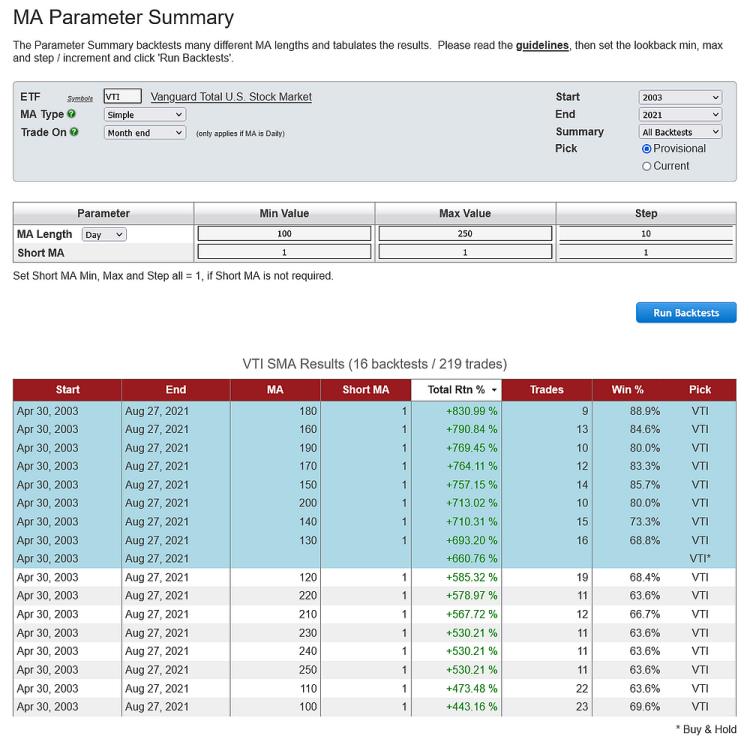Category: Channel
Oct 20, 2022
in Moving Average, Channel
Trend following approaches, such as Moving Averages and Channels, preserve capital by cutting losses and as such they need sustained bear markets to outperform.
While they will generally capture the bulk of a bull market, the inherent lag means that a trend strategy can never sell at the high of an up move and can end up surrendering significant gains before exiting.
Consequently, outside of bear markets, the best they can do is to be fully invested and match the performance of the benchmark. However, bull market corrections and the short-lived directional moves of sideways markets mean that trend-following methods will inevitably suffer some whipsaw losses.
In other words, lengthy periods of underperformance should be expected in bull and range-bound markets. For those that can endure these mentally taxing and financially challenging periods, the pay off is the avoidance of major bear market drawdowns.
Below are a pair of backtests, a channel and a moving average, on a simple global 60/40 portfolio (VTI 35%, VGK 10%, VPL 10%, VWO 5%, AGG 30% and TIP 10%). Examination of the annual returns shows both the strengths and weaknesses of these trend following methods.

click image to view full size version

click image to view full size version
Portfolio Channel Backtest
Portfolio Moving Average Backtest
Aug 31, 2021
in Backtest, Moving Average, Channel, Ratio, Parameter Summary
We have added three new Parameter Performance Summaries to the website:
As with the Relative Strength and TRD summaries that we introduced in July, each of the above can be accessed from their respective backtests.

Set the min, max and step / increment for each parameter, then click 'Run Backtests' and the tabulated results will be displayed:

Parameter Performance Summaries are available to all (regular and pro) annual subscribers.
** studying the guidelines that we published within the original Parameter Summaries announcement is highly recommended **
Apr 05, 2019
in Channel
Channels are a good, simple supplement that offer an ABSOLUTE look and can be used in conjunction with other RELATIVE studies. Wider channels give your trade room to work. Tighter channels will cause some whipsaw losses. If you are bullish on an ETF based on a range of factors, then running a skewed channel might be a good idea --- ie, run the exit (Sell channel) at 0% but a buy at just 60%... This allows you to get in quickly while still offering room for the investment to work. This study uses a simple 67% / 33% buy/sell trigger with a ~6 month lookback (26-weeks means you will trade usually on a Friday -- if holiday then Thursday). Entries and exits only occur on the close of the last day of the week (Fridays) allowing for easy monitoring. Note that this look has trades that have lasted a while. This is because the sell rules will allow a fair bit of movement before exiting.
Finally, because a channel uses a percentage, it may be easier to see the trend in the ETF than othewise. An uptrend is defined by higher lows and higher highs. A downtrend is defined by lower highs and lower lows. The channel is a another tool to have to see and understand what is happening in the market.

Jun 08, 2016
in Channel
We recently added Total Return percentile channels to our range of backtesting tools.
The primary focus of ETFreplay has always been on relative strength analysis and we have tended to see moving averages as serving largely as an easy to understand introduction to backtesting in general.
Like basic MAs, channels are a trend following approach that use only an ETFs own past return history. i.e. they are not relative.
However, unlike MAs, channels are defined by two measures (highs and lows) rather than just one, which intuitively makes sense as an uptrend is a series of higher lows and higher highs. This also means that channels automatically adjust to volatility.
i.e. in a wide swinging trading range the channel boundaries will be far apart, whereas when the market winds down into tight range the channel will be narrow.
Standard channels are simply the highest and lowest values over the prior x days, weeks or months and the use of channel breakouts in trend following is long established. However, for investors such wide channels can mean:
- Slow responsiveness. Trade frequency is extremely low because it takes a lot to enter a position and a very large change to trigger an exit.
- Whipsaw losses, when they occur, are painfully large.
To ameliorate these problems, the backtests allow percentiles of the channel to be employed (the defaults being the 75th percentile for buys and 25th percentile for sells). Doing so means that positions are entered / exited sooner, but the channel still remains wide enough to mitigate against frequent quick whipsaws.
See:
Single ETF channel backtest
Portfolio channel backtest (subscribers)